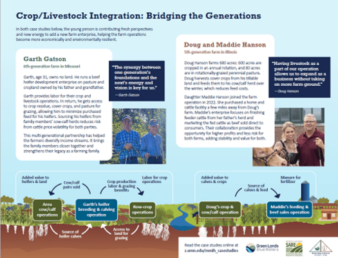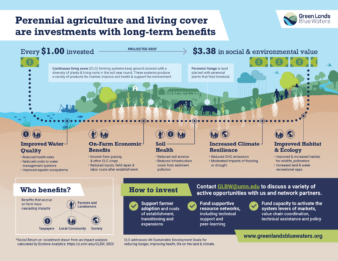Find here communication tools for your own outreach about making the case for continuous living cover agriculture – case studies, reports, analyses, infographics, lit references, media contacts, and more below. Come back often because we are always adding new materials!
Making the Case for CLC
CLC Special Journal
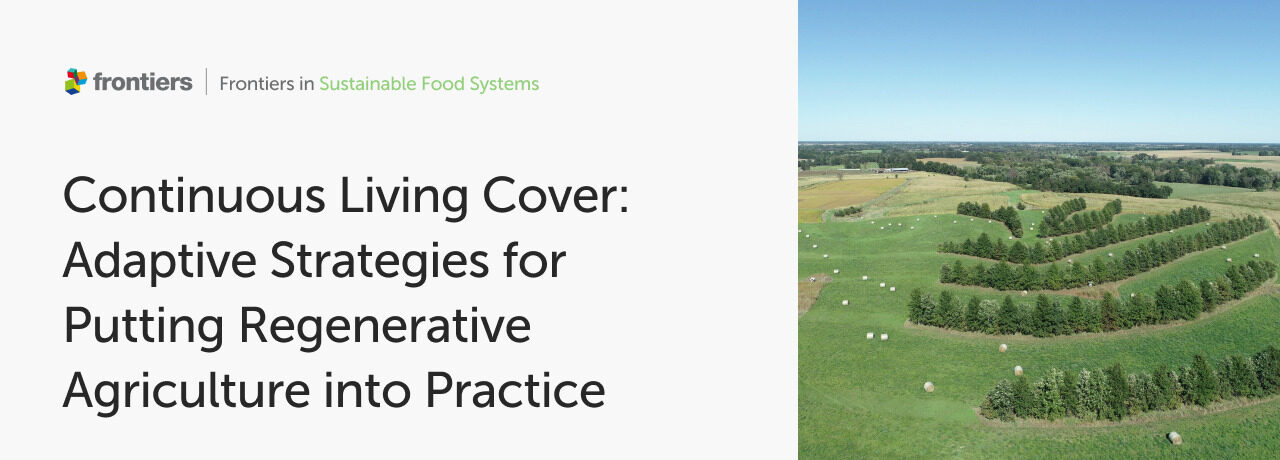
Special CLC Research Topic through Frontiers in Sustainable Food Systems
GLBW’s Continuous Living Cover Research Topic of 23 research articles by 90 authors is available online, open access! The Research Topic is in the Agroecology and Ecosystem Services section of Frontiers in Sustainable Food Systems and includes an editorial that defines and contextualizes the concept of CLC.
Also see our newsletter on this collection, highlighting the editorial team and their editorial on CLC.
You can download an ebook of the collection from the landing page for the Research Topic.
Continuous Living Cover (CLC) refers to agricultural systems in which there are living plants and roots in the ground throughout the year, including winter cover crops sown between annuals, agroforestry plantings with both trees and herbaceous species, managed grazing systems, and perennial grain, forage, and biomass production. This Research Topic focuses on CLC as it relates to the American Midwest and the unique climatic, policy, social, and economic aspects of this region.
Contact Evelyn Reilly reill163[at]umn.edu with any questions about this research topic.
CLC champion spotlights from the paper Our Journey to a Transformed Agriculture through Continuous Living Cover
a. We need to support today’s farmers
- SPOTLIGHT – Tsyunhehkw^ Farm
- SPOTLIGHT – Mark Peterson working with Practical Farmers of Iowa
- SPOTLIGHT – Illinois Fall Covers for Spring Savings Program
b. We need to create opportunities for tomorrow’s farmers
- SPOTLIGHT – Breslin Farms
- SPOTLIGHT – Singing Hills Dairy/ Grow a Black Farmer
- SPOTLIGHT – George Boody and the Severson Family on reintegrating livestock in row crop country
c. We need to equip the next generation of agricultural professionals
- SPOTLIGHT – Dr. Britt Moore
- SPOTLIGHT – Hannah Stoll, Ph.D. student
- SPOTLIGHT – Intertribal Agriculture Council
- SPOTLIGHT – Moses Momanyi, Dawn2Dusk Farm & Kilimo
d. We need to increase funding for research and development of new crops and cropping systems
- SPOTLIGHT – Sustainable Agricultural Systems Coordinated Agricultural Projects (SAS CAPs)
- SPOTLIGHT – Illinois Regenerative Agriculture Initiative (IRAI)
- SPOTLIGHT – The Forever Green Initiative (FGI)
e. We need to activate the system levers of markets, policy, and investment capital; and implement with a cross-sector networked approach
Outcomes of CLC - Climate, Environmental & Social Resilience
This section includes selected climate-focused science and policy briefs developed by GLBW and partners to help navigate through some of the hopes and claims about climate-smart ag. New approaches to transform agriculture also open doors to address social inequalities by increasing access and opportunities for farmers, supply chain partners, and agricultural professionals.
2023 Ag Carbon Recommendations informed by the 2022 MN Ag Carbon Tracking and Monitoring Workshop
In July, 2022, 60+ cross-sector partners convened for a virtual Ag Carbon Tracking and Monitoring workshop. Informed by the 2022 workshop, white papers with recommendations for various audiences were completed in 2023.
- MN Ag Carbon Tracking and Monitoring Workshop, Post-Workshop Report – MN partners, July 2022
2023 Recommendations for specific audiences from the Agricultural Carbon Tracking and Monitoring Workshop
- Minnesota Community-Based and Farmer Organization Recommendations – August, 2023
- Legislative Policy Recommendations – August 2023
- Agency Policy Recommendations – August 2023
- Researcher Recommendations – August 2023
Additional climate, environment & social resilience resources by GLBW & partners
- Agricultural Opportunities for a Climate-Smart Minnesota. Friends of the Mississippi River – March 2022
- Brief: Environmental & Social Outcomes of CLC Strategies. GLBW & Partners, 2021
- Regenerative agriculture can provide many environmental benefits, but is not a “silver bullet” for climate change mitigation. Drs. Jessica Gutknecht and Jacob Jungers, University of Minnesota – March 2021
Social Return on Investment (SROI) of Perennial Forage & CLC - Ecotone
GLBW endeavors to develop distinct and effective tools for our network partners to Make the Case for CLC in their work and to their funders. GLBW engaged Ecotone Analytics to begin to develop return on investment tools as a different way to characterize Continuous Living Cover and communicate its benefits.
In the project documentation, Ecotone identifies that the need for CLC adoption and the mission and purpose of GLBW make it a potentially highly valuable vessel for raising and funneling funding and investment for network partner projects.
Ecotone Analytics is an impact accounting organization that does benefit-cost analysis for clients’ social and environmental impacts. Combining evidence-based research analysis and monetization of impact outcomes, Ecotone derives a social return on investment ratio. Social Return on Investment (SROI) is an adaptation of the financial ROI metric. It is used to measure social, environmental, and economic gains (also referred to as returns) as a result of an investment.
With GLBW and many GLBW partners (huge thanks for your input!), Ecotone Analytics conducted an impact analysis and calculated an SROI focusing on the Perennial Forage and Grazing (PFG) strategy of CLC. The analysis takes a benefit-cost approach to external literature of the highest available level of evidence of causality to estimate the total social, environmental and economic value generated by PFG. The prospective valuation approach used compares the estimated outcomes achieved by PFG against the environmental impacts of annual row crops in the Upper Midwest.
Following their research and analysis, Ecotone projects that the SROI achieved by the PFG strategy will be approximately $3.38. For every $1 dollar in investment made in supporting the establishment of a perennial pasture and grazing system on farms with livestock, a projected $3.38 in social and environmental value will be generated, with benefits flowing to farms, taxpayers, community members, municipal water users, and the broader global society. The largest outcome monetized was the projected reduced costs of eutrophication due to avoided nutrient runoff, followed by the financial returns accruing to the farm.
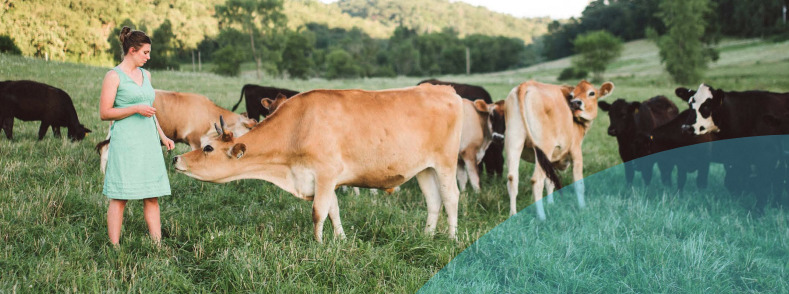 Photo by Susie Theis
Photo by Susie Theis
Two financial hurdles that INVESTORS CAN HELP OVERCOME are upfront investment costs and opportunity costs for the farmer, in return fostering larger environmental services as well as potentially supporting financial well-being on the farm. Investing in Perennial Forage and CLC benefits the farmer and their communities and extends to the environment and society at large.
- As illustrated in this “Journey Map” of benefits
The impact value map and overview brochure shows the estimated cost per acre for pasture and grazing system establishment and the projected benefits per acre per year from adopting perennial forage and grazing strategies, in comparison to conventional practices.
Elements of the Impact Overview Brochure are provided below as individual graphic files for your use.
- Five Dimensions of Impact of Continuous Living Cover
- Ag Transformation Indicators of Perennial Forage and CLC
- Logic Model for a network/collaborative approach to implementing CLC
- Impact Value Map for the Social and Environmental Impact of Perennial Forage and Grazing in the Upper Midwest
Find below supplemental materials about the analysis, providing technical information and user and communications guidance.
Putting Down Roots report on the benefits of CLC in MN
Source Water Protection with Kernza®
- Fact Sheet: Minnesota Projects to Protect Drinking Water with Kernza Perennial Grain – GLBW, Sept 2021
- Kernza Field Trial Results: Pipestone and Chatfield, MN – GLBW, Mar 2022
- Project Snapshot: VERDI, MN – Project to Protect Drinking Water with Kernza Perennial Grain – GLBW, Feb 2020
- Project Snapshot: COLD SPRING, MN – Project to Protect Drinking Water with Kernza Perennial Grain – GLBW, Feb 2020
- Paper: Policies and Programs Supporting Perennial Farming Systems to Protect Drinking Water in Minnesota – GLBW, Apr 2019
Infographics
Partnerships Overcome Challenges of Crop & Livestock Integration
Crop & Livestock Integration: Bridging the Generations
Diverse Perennial Circular Systems for Agricultural Resilience from the Resilience CAP project
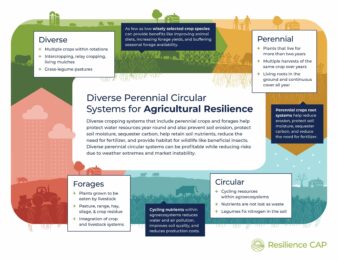 This work is supported by AFRI Sustainable Agricultural Systems Coordinated Agricultural Project (SAS-CAP) grant no. 2021-68012-35917 from the USDA National Institute of Food and Agriculture.
This work is supported by AFRI Sustainable Agricultural Systems Coordinated Agricultural Project (SAS-CAP) grant no. 2021-68012-35917 from the USDA National Institute of Food and Agriculture.
Match Made in Heaven: Livestock + Crops
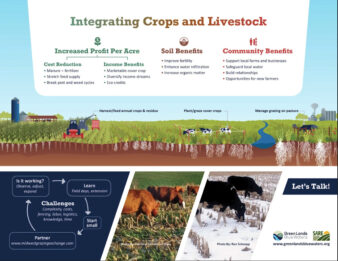 Infographic: Match Made in Heaven: Livestock + Crops
Infographic: Match Made in Heaven: Livestock + Crops
Benefits of Investing in Perennial Forage & CLC
Infographic: Journey Map of Investing in Perennial Forage & CLC
Perennial Forage for Infrastructure Protection infographic
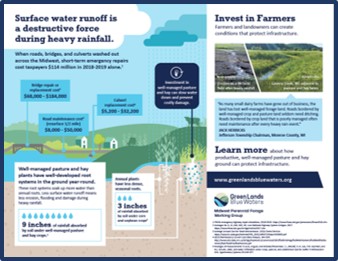 Infographic: Perennial Forage for Infrastructure Protection
Infographic: Perennial Forage for Infrastructure Protection
PDF Web Version (8.4 Mb)
PDF Print Version (13.4 Mb)
For more information on these topics, visit our Midwest Perennial Forage Working Group page.
Slide decks for shared use on Infographics and Ecotone Analysis
- GLBW Infographic Slides: PDF
- Match Made in Heaven Livestock + Crops: PDF JPG
- Benefits of Investing in Perennial Forage & CLC: PDF JPG
- Perennial Forage for Infrastructure Protection: PDF JPG
- Blank Branding Slide: PDF JPG
- Ecotone Analytics: PDF JPG
- Five Dimensions of Impact: PDF JPG
- Ag Transformation Indicators: PDF JPG
- Logic Model Network Approach to CLC: PDF JPG
- Impact Value Map for the Social and Environmental Impact of Perennial Forage and Grazing in the Upper Midwest: PDF JPG
- Ecotone Analytics Impact Analysis Summary: PDF JPG
- Ecotone & GLBW in Partnership: PDF JPG

